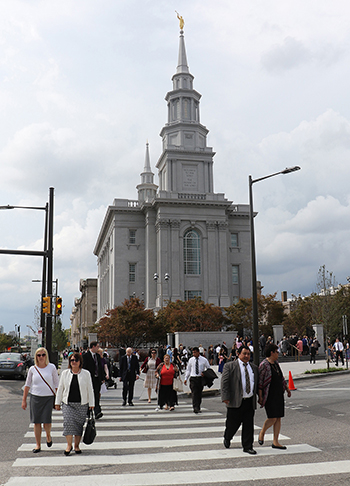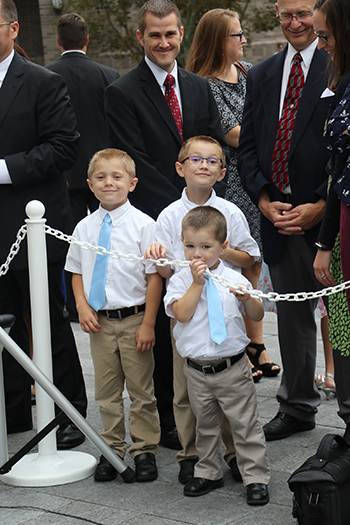Philadelphia Pennsylvania Temple Elevates the City of Brotherly Love
Contributed By Sarah Jane Weaver, Church News associate editor

Church leaders and their wives stand outside the Philadelphia Pennsylvania Temple on September 17, 2016.
Related Links
In the 17th century, William Penn—an advocate of democracy—undertook a “holy experiment” and founded the city of Philadelphia on the principles of religious freedom.
A century later, delegates gathered in the city for the Constitutional Convention—creating the U.S. Constitution and preserving religious freedom.
And on September 18, the feeling that something important was once again beginning in the historic city returned to Philadelphia. President Henry B. Eyring, First Counselor in the First Presidency, dedicated the Philadelphia Pennsylvania Temple. Thousands of Church members from 11 stakes participated in the dedication on the weekend anniversary of the September 17, 1787, signing of the Constitution.
The temple—located near Philadelphia City Hall, where a prominent statue of founder William Penn graces the cityscape—celebrates the “history that is here,” said President Eyring, who was baptized a member of the Church in Philadelphia.
“Somehow it feels a little special,” he said, “to know you are in a place where the Lord had His hand in the forming of this nation.”

Crowds of people outside the Philadelphia Pennsylvania Temple following dedication ceremonies September 18, 2016—the weekend anniversary of the September 17, 1787, signing of the U.S. Constitution. Photo by Sarah Jane Weaver.

President Henry B. Eyring, First Counselor in the First Presidency, dedicated the Philadelphia Pennsylvania Temple on September 18, 2016—the weekend anniversary of the September 17, 1787, signing of the U.S. Constitution. Photo by Sarah Jane Weaver.

Joseph, 7, Alex, 5, and Jacob, 2, Bloomfield stand in front of the Philadelphia Pennsylvania Temple on September 18, 2016, awaiting the cornerstone ceremony. Photo by Sarah Jane Weaver.

President Henry B. Eyring, First Counselor in the First Presidency, dedicated the Philadelphia Pennsylvania Temple on Sunday, September 18, 2016. Photo by Sarah Jane Weaver.
The 61,000-square-foot temple features classic Georgian architecture designed to blend with historic Philadelphia. The Church’s 152nd temple worldwide, it serves more than 40,000 Latter-day Saints in parts of Pennsylvania, New Jersey, and Maryland and all of Delaware.
Elder D. Todd Christofferson of the Quorum of the Twelve Apostles grew up in New Brunswick, New Jersey—an area included in the Philadelphia Temple district.
He too has a great appreciation for the Founding Fathers and the Constitution.
The Lord raised men to create that document, he said. Now “He has raised up the Church to this day when we can have a temple like this.”
The area is also historically significant for the Church. Joseph Smith translated much of the Book of Mormon while living in Harmony, Pennsylvania. The priesthood was restored and Joseph and Oliver Cowdery were baptized in the Susquehanna River, about 150 miles north of Philadelphia.
“Now to have a temple in the area is a great blessing to commemorate the tremendous history of the Church,” said Elder Milan F. Kunz, an Area Seventy and chairman of the local temple committee.
A beautiful, original painting in the lobby of the new temple portrays the signing of the Constitution—a “divinely inspired document” that allowed “the Church of Jesus Christ to be restored and flourish in this country,” he said.
Artist Jonathan Linton, who worked on the painting for more than two and a half years, said he wanted to remind viewers “of the divine hand of God in our government’s creation.”
He also hoped the painting would be a “bridge for those not of our faith to connected with us, since the Constitution is something we all revere.”
And many local government and civic leaders saw the painting while touring the Philadelphia Temple during its open house, held August 10 through September 9; of the 141,000 people who visited the temple, Elder Kunz said more than half were members of other faiths.
Many appreciated the unique architecture of the temple—which with its location on the Benjamin Franklin Parkway next to the Old Family Court and the Free Library—looks like it “has been here for many years, just like these other buildings.”
It looks like it fits, “but you can tell distinctively it is our temple,” said Jordan Peterson, president of the Philadelphia Pennsylvania Stake.
The temple has lifted the spirits of the members in the City of Brotherly Love, he said.
“The Church is here in Philadelphia and they are part of it and it is meaningful,” he said.
Because Philadelphia was established on the basis of religious freedom “it attracted people from all over the world,” said Jon Stephenson, history chair for the local temple committee.
This led to successful missionary efforts in the Philadelphia metro area in the 1840s—where the early Church had 16 branches. Prominent Church leaders—including Joseph Smith—visited and preached in Philadelphia.
“There is no question we have a rich and deep LDS history here,” said Brother Stephenson.
“Why was it so successful here? It was part of the Quaker tradition, the Quaker way. Other faiths were welcome.”
That tradition continues today, where Church growth is expected in Philadelphia, in part because of the visibility of the new temple.
Steve and Jill Ross, ushering chairs on the local temple committee, love that the angel Moroni statue on the new temple and the William Penn statue on Philadelphia City Hall look across the Philadelphia skyline at each other. “There is something significant in coming to a place where freedoms are so appreciated,” said Sister Ross. “The right to worship as we see fit goes along with it.”
Donte and Rosalyn Holland joined the Church in 2003. Their daughter Nyla is a second-generation member here and looks to the temple for peace. “It is hard being a black, female teenager in Philadelphia, while being Mormon,” she said. “I know the temple is a place I don’t have to worry about being different.”

President Henry B. Eyring, First Counselor in the First Presidency, and Elder D. Todd Christofferson of the Quorum of the Twelve Apostles participate in the Philadelphia Pennsylvania Temple cornerstone ceremony on September 17, 2016. Photo by Sarah Jane Weaver.
Lowell and Joan E. Young moved to the area in 1967. A year later, in 1968, it was announced that the Washington D.C. Temple would be built. Thinking they would never have another opportunity to donate substantially to the construction of a temple, the Youngs gave the money they had been saving to buy a house to the temple fund.
Having a temple in Philadelphia is a blessing they never imagined in those early years. The temple, Brother Young said, “influences everything you do.”
“When you live in a city that has this much history, it becomes part of you too,” said Sister Young.
Josephine T. Scere was born and raised in Philadelphia and baptized at age 14. Sometimes it is hard to live the gospel where there is “such vitality in city life,” she said. But the members “find a way to make it work every single day”—embracing all the good from their culture and taking it to the Church.
Now the temple “is definitely a sense of identity for us here,” she said. The temple “represents us in such a diverse place, where so many of the people we identify with are not members of the Church. Yet here is a beacon to them of what we are and what we believe.”
When you look at the skyline where there is so much history, she explained, the temple “elevates the city.”

A crowd waits in front of the Philadelphia Pennsylvania Temple for the cornerstone ceremony on dedication day, September 18. Photo by Sarah Jane Weaver.

President Henry B. Eyring, First Counselor in the First Presidency, dedicated the Philadelphia Pennsylvania Temple on Sunday, September 18, 2016. Photo by Sarah Jane Weaver.

President Henry B. Eyring, center, with, from left, Elder Larry Y. Wilson, Elder D. Todd Christofferson, Elder Gerrit W. Gong, and Elder Anthony D. Perkins outside the Philadelphia Pennsylvania Temple on September 17, 2016. Photo by Sarah Jane Weaver.

A choir sings at the cornerstone ceremony of the Philadelphia Pennsylvania Temple on September 18, 2016. Photo by Sarah Jane Weaver.

Elder D. Todd Christofferson and his wife, Sister Kathy Christofferson, at the cornerstone ceremony of the Philadelphia Pennsylvania Temple on September 18, 2016. Photo by Sarah Jane Weaver.

Audrey and Andrew Cleveland sit near the Philadelphia Temple after the second dedication session on September 18, 2016. Photo by Sarah Jane Weaver.

President Henry B. Eyring, First Counselor in the First Presidency, dedicated the Philadelphia Pennsylvania Temple on September 18, 2016—the weekend anniversary of the September 17, 1787, signing of the U.S. Constitution. Photo by Sarah Jane Weaver.

Rosalyn, Donte, and Nyla Holland stand in front of the Philadelphia Pennsylvania Temple. Photo by Sarah Jane Weaver.

President Henry B. Eyring, First Counselor in the First Presidency, dedicated the Philadelphia Pennsylvania Temple on Sunday, September 18, 2016. Photo by Sarah Jane Weaver.
